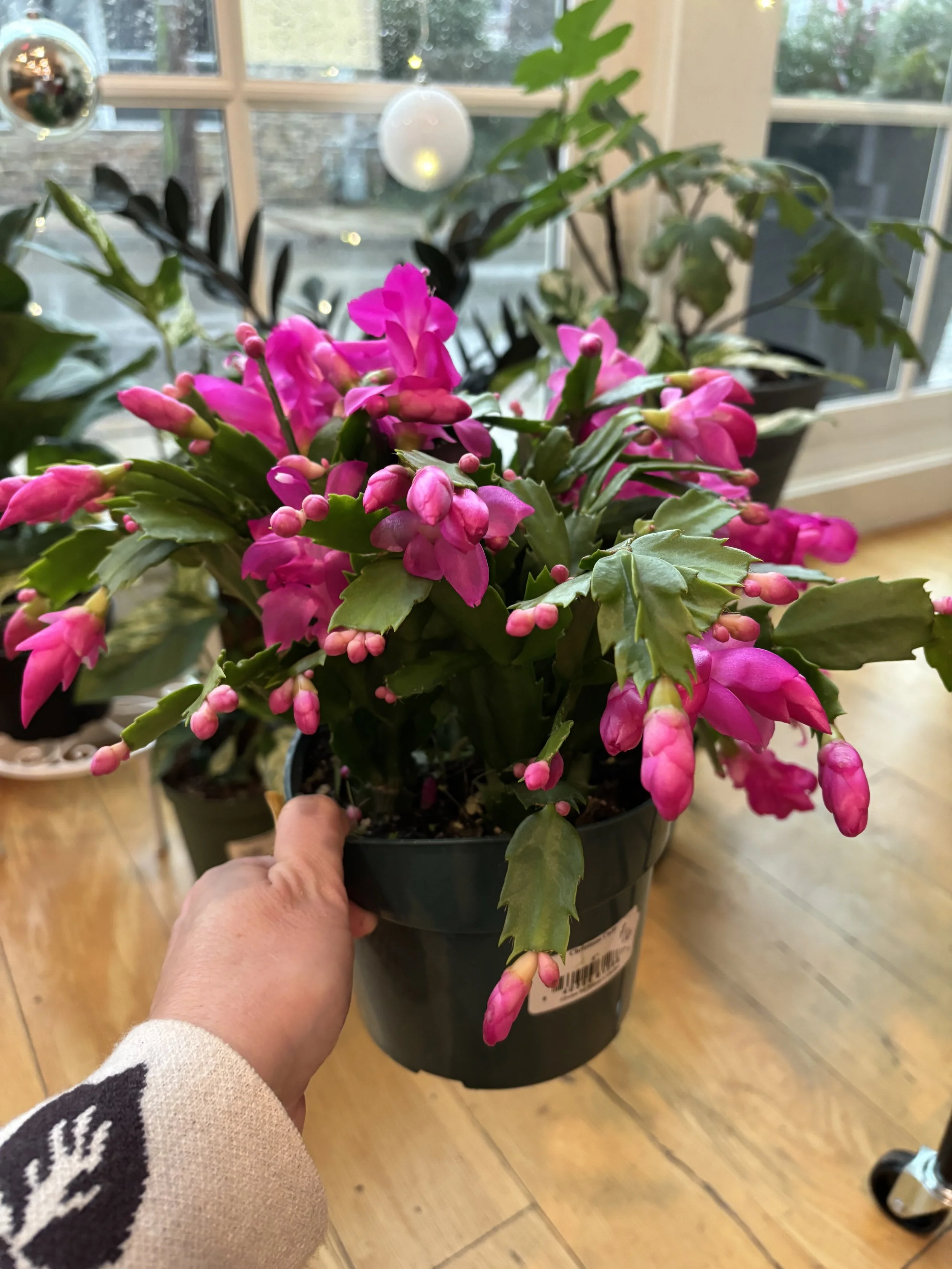Caring for Your Holiday Plant Favorites
Whether you’re decorating your home, gifting something beautiful, or brightening up the darker days, classic winter flowers bring the holiday vibe all season long. Here’s your guide to four beloved holiday plants and tips to keep yours thriving! We’ll cover poinsettia, Christmas cactus (zygocactus), cyclamen, and amaryllis.
Poinsettia (Euphorbia pulcherrima)
A holiday icon with vibrant bracts (those are the leaves!) that range from classic red to pink, white, or speckled. They’re easier to care for than most people think.
Care Tips
Light: Bright, indirect light (they don’t like harsh sun).
Water: Keep soil lightly moist. Water when the top inch feels dry and drain any excess water, so the roots don’t sit in it.
Temperature: 65–75°F They do not like temperature swings or drafts so keep them away from doors that open regularly or radiators and heat vents.
Fun Fact: Those colorful “flowers” are actually leaves called bracts. The real flowers are the tiny yellow centers! They are “short-day” plants, and those leaves change from green to red/pink/white in response to fewer hours of daylight.
After the Holidays
If you want to keep your poinsettia long-term, you can. They naturally drop bracts in spring—don’t panic. Cut it back, give it bright light, and let it spend the summer outdoors before exposing it to dark periods to get the bracts to change from green to colors for next season.
Christmas Cactus (Zygocactus / Schlumbergera)
This winter-blooming cactus is a favorite for its arching stems and brightly colored flowers. Unlike desert cacti, it comes from humid Brazilian forests and requires different care.
Care Tips
Light: Bright, indirect light. Too much sun can burn new growth.
Water: Keep soil slightly moist but never soggy. Water when the top 1–2 inches dry out.
Humidity: Loves a little extra humidity; avoid hot, dry rooms or being close to heat vents or radiators.
Temperature: They bloom best in cooler temps (60–70°F).
How they bloom: A few weeks of cooler nights and longer darkness in the fall help form the flower buds. In subsequent years, nature’s change in temperatures and daylight will help your cactus bloom again in late fall.
After Blooming
Zygocacti can live for decades, and the stems can be easily propagated. In some families they are passed down through generations!
Cyclamen (Cyclamen persicum)
Cyclamen have charming heart-shaped leaves, beautiful flowers in several colors, and thrive in cool weather, making them perfect for winter displays.
Care Tips
Light: Bright, indirect light.
Water: Water when the soil is dry about 1 inch down. Water from the bottom, if possible, to keep the tuber dry and avoid rot.
Temperature: Prefers cool rooms, ideally 50–65°F.
Trick: If your cyclamen wilts even when watered, it’s likely too warm. Move it somewhere cooler, and it will perk back up. It is also forgiving when you forget to water, and the leaves become very dramatic, drooping as if you left it for a month! Water will bring it back to health.
After Blooming
Cyclamen naturally go dormant. Yellowing leaves don’t mean death, they mean rest! Let the foliage die back, stop watering, and start again in late summer when new growth appears.
Amaryllis (Hippeastrum)
Nothing brings holiday drama like an amaryllis. With huge trumpet-shaped flowers in bold reds, whites, candy-stripes, and even deep burgundy, they’re a showstopper.
Care Tips
Light: Bright light to grow strong stalks. Once the flowers open, move away from bright light for longer-lasting blooms.
Water: Water sparingly until you see 2 inches of growth, then keep the soil evenly moist. If your bulb is coated in wax, no water is needed.
Temperature: Room temperature is perfect. Warmer rooms encourage faster blooming.
Support: Large varieties sometimes need a stake to keep the blooms upright.
Reblooming
After flowers fade, cut the spent blooms, but keep the stalk until it yellows naturally. Let the plant grow like a leafy houseplant through summer, feeding monthly, then give it 8–10 weeks of cool, dark rest in fall. After that, bring it back to light and water—and the cycle begins again!
Highlights of the Winter Season
Whether you love the classic red poinsettia, the charm of a winter-blooming cactus, the delicate curls of cyclamen flowers, or the bold drama of amaryllis, these plants add warmth and joy to the coldest months. With a little care, they’ll keep your home cheerful well into the new year, and with a little care, they can come back year after year.
If you’d like help choosing the perfect plant, stop by Plant 4 Good. We’re always happy to help you grow with confidence this holiday season.
Poinsettia on display at
Longwood Gardens




